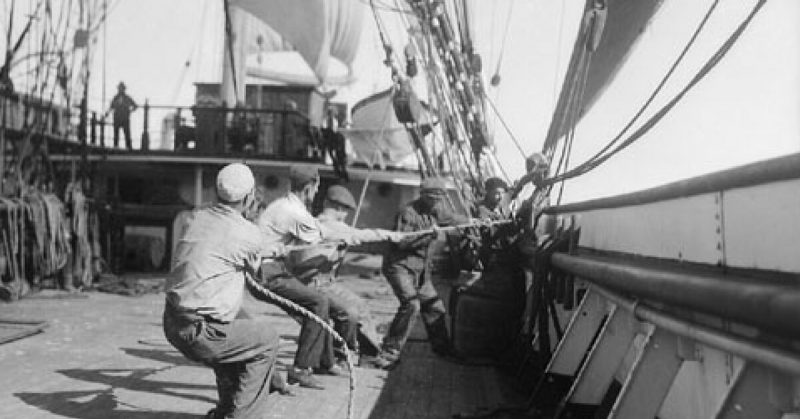Sailors have always been happy singing, whether to make the day go faster or keep the work going steady.
The Royal Navy banned the use of shanties, or work songs, on their ships, but sailors would sing when given an opportunity. Most often this meant dancing, singing, and skylarking on the forepeak, the ideal respite after a day of hard work.
The songs would either be a jig or reel from their hometowns; something fast and straightforward to dance along with.
At other times they were strong, heartfelt ballads about their lives, or historical events. These songs often complained about their hard life at sea, praised the bravery of the seamen, or lamented their poor treatment by their superiors.
What was more usual, though, were songs about what they missed while at sea; freedom, or more likely – a woman.
Following are three such songs.
First: Spanish Ladies (also known as Farewell and Adieu, and Farewell and Adieu to you Spanish Ladies)
This song dates back to at least 1796, where it appeared in the logbook of HMS Nellie on convoy between Spain and England during the War of the First Coalition. England was aiding Spanish forces in their fight against revolutionary France. It is almost impossible to determine when the song was penned.
Regardless of its origin, the song’s meaning is clear: it describes a ship working its way back up the channel to English waters, in a dense fog. The sailors are sorry to leave the exotic Spanish women behind and to be trapped again in a wooden ship, blindly feeling its way home. They do not relent, however, and keep their spirits up like true British Tars.
Lyrics can be found here.
Second: Ben Backstay
This song describes the terror administered by a Boatswain, essentially a ship’s foreman, and then his unfortunate demise. The position was usually held by an older seaman, who could hold his own in a fight and who was willing to enforce the Captain’s word and orders when necessary.
The first verse gives a clear description of who Ben Backstay was, an angry Boatswain who cheerily wrought havoc on the sailors, with whips and beatings. Towards the end of the song, it turns into a humorous warning not to mix your spirits, as it can make it too easy to get drunk. There is little written about the exact origin of this version of the song, but it likely dates from the early 19th century. It was written by Charles Dibdin, who wrote another song by the same name, but with an entirely different story.
Lyrics can be found here.
Finally: Boney was a Warrior
This song moves away from a sailor’s life and focuses on history. It details the early rise and eventual demise of Napoleon Bonaparte (Boney).
Its origin is unknown, but it was possibly written, and later sold, by a broadside ballad writer within a few months of the French defeat at Waterloo. Broadside Ballads were the radio of their day. Songs written and printed quickly, purchased for a few pennies, and taught on the spot.
These songs would travel around the country, some gaining popularity. This one became particularly popular among naval and merchant sailors alike. The merchant sailors liked it as a short haul shanty, a work song used for pulling on a line. The Navy sailors enjoyed it because it probably annoyed their officers.
Lyrics can be found here.
Songs like these became an ever-present backdrop to the lives of Royal Navy sailors in the early 19th century. Most of the seamen of the time took refuge in song; it built relationships with their shipmates and often provided a good laugh.
So, to their memory, drink up a full bumper, and let loose a round of Spanish Ladies, Roast Beef of Old England, or Hearts of Oak!
